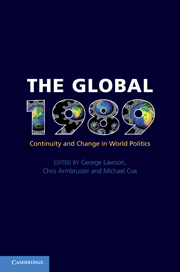Book contents
- Frontmatter
- Contents
- List of figures
- List of tables
- Notes on contributors
- Acknowledgements
- List of abbreviations
- Introduction: the ‘what’, ‘when’ and ‘where’ of the global 1989
- Part I What and when
- Part II Where
- 4 Transatlantic relations in the shadow of the Cold War
- 5 Third World socialism: 1989 and after
- 6 Towards a global Europe?
- 7 Restoration and convergence: Russia and China since 1989
- 8 One world, many cold wars: 1989 in the Middle East
- Part III Continuity and change
- Conclusion: was there a global 1989?
- Bibliography
- Index
5 - Third World socialism: 1989 and after
Published online by Cambridge University Press: 05 June 2012
- Frontmatter
- Contents
- List of figures
- List of tables
- Notes on contributors
- Acknowledgements
- List of abbreviations
- Introduction: the ‘what’, ‘when’ and ‘where’ of the global 1989
- Part I What and when
- Part II Where
- 4 Transatlantic relations in the shadow of the Cold War
- 5 Third World socialism: 1989 and after
- 6 Towards a global Europe?
- 7 Restoration and convergence: Russia and China since 1989
- 8 One world, many cold wars: 1989 in the Middle East
- Part III Continuity and change
- Conclusion: was there a global 1989?
- Bibliography
- Index
Summary
Conjunctures and multiple outcomes
The events of 1989, and their immediate antecedents and consequences, qualify, on any general criteria, as one of the most striking, and unanticipated, international conjunctures of modern history, comparable in the coincidence and interlocking of events with such classic earlier moments as 1648, 1789, 1848, and the ends of the First and Second World Wars. In all of these cases a set of interlocking processes – military, political, economic, ideological – seemed to come in unison to crisis point. The result was both the shattering of established forms of state power, combined with the emergence of new forms of political and social opposition and an ensuing, and often remarkably rapid, recomposition of a new intra- and inter-state order. In such cases, the conjuncture marked both crisis and re-creation, both the culmination and denouement of an earlier set of changes, and the initiation of a new, different order. In all of these cases, the consequences were felt widely across the world, even if, faced with major changes within powerful states, be they France in 1789 or the USSR in 1989–91, states and societies reacted in markedly different ways: an interconnected set of societies and states is not a homogeneous, integrated, totality.
The analytic challenge facing the student of such conjunctures comprises at least three different elements: first, the establishment of a historical record, recognising global context and national specificity of the events of this and adjacent years; second, specification of the international and transnational vectors of the conjuncture (such as environment, international war, economic crisis and ideological upheaval) from those which were more specifically national, random or coincidental; and finally, a delineation of the overall international, regional and global changes which the conjuncture brought about.
- Type
- Chapter
- Information
- The Global 1989Continuity and Change in World Politics, pp. 112 - 134Publisher: Cambridge University PressPrint publication year: 2010
- 2
- Cited by



